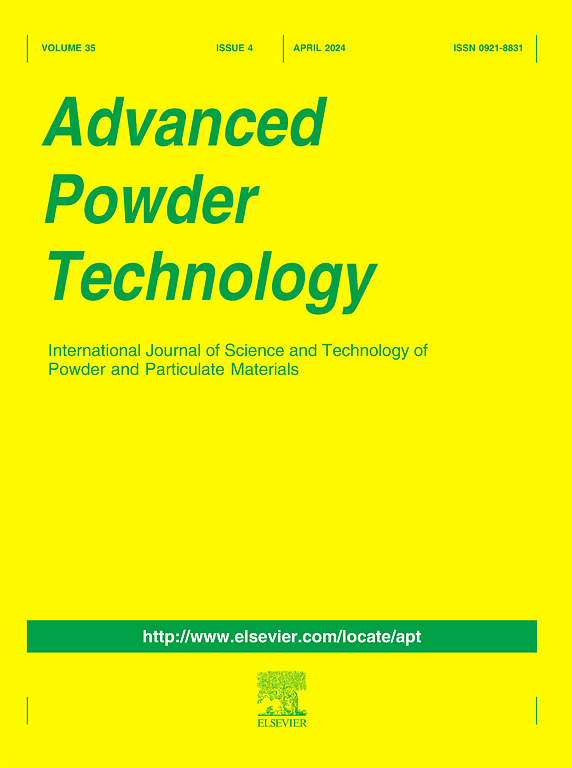波纹几何形状对砂-结构界面特性的影响
IF 4.2
2区 工程技术
Q2 ENGINEERING, CHEMICAL
引用次数: 0
摘要
本文用直接剪切仪对恒定法向载荷作用下的砂与正弦波纹表面之间的界面进行了实验室研究。使用3D打印技术,制作了一个定制的直接剪切盒,可以构建各种波纹表面地形。结果表明,采用熔丝制造方法生产的零件在直接剪切箱中成功地复制了传统金属部件的性能。采用不同正弦波纹面进行了一系列界面剪切实验。评估了波纹系数d/l (d代表波深,l代表波长)与界面剪切阻力之间的关系。结果表明,随着波纹系数的增加,施加在表面的力和体积变化也增加。力测量提供了对表面的摩擦系数,范围从0.335到0.883。利用数字图像相关技术(DIC)对剪切带的微观行为进行了分析,从而对不同表面的破坏机制进行了定性描述。对于低波纹表面,可以观察到材料沿着表面直接滑动,而对于高波纹表面,剪切面出现在波纹谷上方,材料内部和波纹峰处。确定了0.053 ~ 0.147的临界波纹系数作为高低波纹界面之间的阈值。基于DIC分析,确定剪切带厚度,范围为4×d50 ~ 5×d50。最后,这项研究为颗粒材料和正弦波纹表面之间的界面的微观行为提供了有价值的见解。本文章由计算机程序翻译,如有差异,请以英文原文为准。

Influence of corrugation geometry on sand-structure interface behavior
This paper presents laboratory investigations on the interface between sand and a sinusoidal corrugated surface under a constant normal load using a direct shear apparatus. Using 3D printing technology, a custom direct shear box was fabricated, enabling the construction of various corrugated surface topographies. It was shown that parts produced by FFF (Fused Filament Fabrication) method successfully replicated the properties of traditional metal components in the direct shear box. A series of interface shearing experiments was conducted using different sinusoidal corrugated surfaces. The relationship between the corrugation coefficient, (where d represents wave depth and l represents wavelength), and the shear resistance of the interface was evaluated. Findings revealed that as the corrugation coefficient increased, the forces exerted on the surface and the volumetric changes also increase. Force measurements provided a friction coefficient against the surface, ranging from 0.335 to 0.883. The micro-behavior of the shear zone was analyzed using Digital Image Correlation (DIC), which enabled a qualitative description of failure mechanisms for various surfaces. For surfaces with low-corrugated, direct sliding of the material along the surface was observed, whereas for high-corrugated surfaces, the shear plane appeared above the corrugation valleys, within the material, and at the corrugation peaks. A critical corrugation coefficient, ranging from 0.053 to 0.147, was identified as the threshold between low-corrugated and high-corrugated interfaces. Based on the DIC analysis, the thickness of the shear zone was determined, ranging from 4 to 5. Finally, this research provides valuable insights into the micro-behavior of the interface between granular material and sinusoidal corrugated surfaces.
求助全文
通过发布文献求助,成功后即可免费获取论文全文。
去求助
来源期刊

Advanced Powder Technology
工程技术-工程:化工
CiteScore
9.50
自引率
7.70%
发文量
424
审稿时长
55 days
期刊介绍:
The aim of Advanced Powder Technology is to meet the demand for an international journal that integrates all aspects of science and technology research on powder and particulate materials. The journal fulfills this purpose by publishing original research papers, rapid communications, reviews, and translated articles by prominent researchers worldwide.
The editorial work of Advanced Powder Technology, which was founded as the International Journal of the Society of Powder Technology, Japan, is now shared by distinguished board members, who operate in a unique framework designed to respond to the increasing global demand for articles on not only powder and particles, but also on various materials produced from them.
Advanced Powder Technology covers various areas, but a discussion of powder and particles is required in articles. Topics include: Production of powder and particulate materials in gases and liquids(nanoparticles, fine ceramics, pharmaceuticals, novel functional materials, etc.); Aerosol and colloidal processing; Powder and particle characterization; Dynamics and phenomena; Calculation and simulation (CFD, DEM, Monte Carlo method, population balance, etc.); Measurement and control of powder processes; Particle modification; Comminution; Powder handling and operations (storage, transport, granulation, separation, fluidization, etc.)
 求助内容:
求助内容: 应助结果提醒方式:
应助结果提醒方式:


